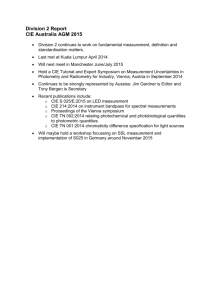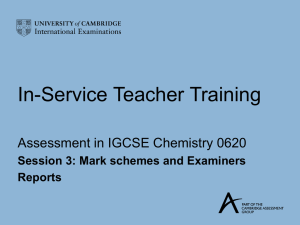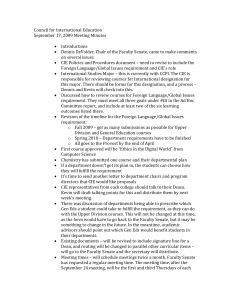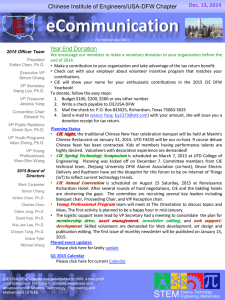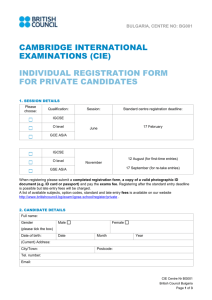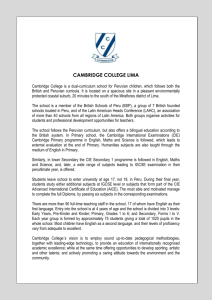Session 3 0580
advertisement
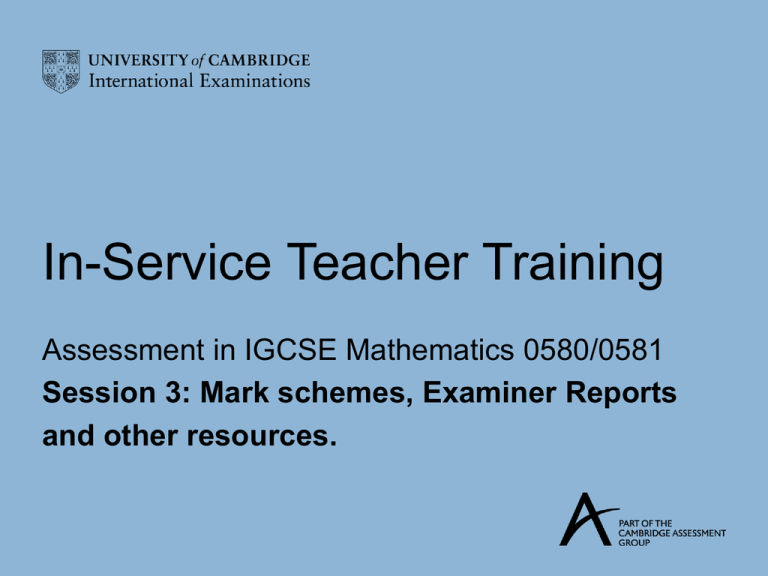
In-Service Teacher Training Assessment in IGCSE Mathematics 0580/0581 Session 3: Mark schemes, Examiner Reports and other resources. www.cie.org.uk Welcome • Introductions • Background • Aim of training www.cie.org.uk Session 3 looks at: • Using the mark scheme • Using Examiner Reports • Additional resources for IGCSE Mathematics www.cie.org.uk Using mark schemes (1): The importance of mark schemes Mark schemes: • • • • Give the allocation of marks Indicate the range of acceptable answers Give examples of unacceptable answers Give an indication of what Examiners are looking for in an answer www.cie.org.uk Using mark schemes (2): Use with the Examiner Report The mark scheme and Examiner Report: • Both give information about each part of each question • Should be used side by side to analyse students’ answers to questions • Provide information which can be passed on to students www.cie.org.uk Using mark schemes (3): Analysis of candidate scripts Take each question in turn and do the following: • Make yourself familiar with the mark scheme • Mark the questions showing clearly where you gave each mark • Bear in mind the marking guidelines given in Unit 2 • When you have finished, compare your marks with those of the Examiner www.cie.org.uk Using Examiner Reports (1): The importance of the Reports • The range of candidate misconceptions is addressed • Areas of weakness of the candidates as a whole are highlighted • Reasons are suggested for common incorrect answers • The correct range of acceptable answers are listed for each question www.cie.org.uk Using Examiner Reports (2): Analysis of contents • Misreading of questions • Incorrect reference or lack of reference to the stem of a question • Shape and Space questions – common threads? • Number questions? • Algebra questions? Graphs? • Statistics and Probability questions? • Advice for future candidates www.cie.org.uk Using Examiner Reports (3): Teaching aims and the Examiner Report • It is useful to analyse Examiner Reports over a number of years • There are a number of misconceptions that regularly appear • There are a number of specific areas which students find conceptually difficult www.cie.org.uk Additional resources (1): CIE Teacher Support website • Syllabuses Examiner Reports dating back to 2001 • Question papers dating back to 2001 (November and June sessions) • All of the associated mark schemes for the question papers • Schemes of work www.cie.org.uk Additional resources (2): Schemes of work (1) The scheme of work has 10 Units: 1) Number and Algebra (Core) 2) Further Number and Algebra (Core) 3) Shape and Space (Core) 4) Geometry (Core) 5) Statistics and Transformations (Core) www.cie.org.uk Additional resources (3): Schemes of work (2) 6) 7) 8) 9) 10) Further Number and Probability (Extended) Further Algebra (Extended) Shape and Space (Extended) Geometry (Extended) Statistics and Transformations (Extended) www.cie.org.uk Additional resources (4): Support test materials • Test materials related to each section of the scheme of work are available • A section of associated exam questions has been produced for each Unit on the scheme of work. Mark schemes are also given www.cie.org.uk Additional resources (5): • CIE discussion groups • Learn CIE website - revision materials for Core and Extended - individual tutorials on every IGCSE Mathematics topic with questions - individual lesson plans on some topics - an online test centre • Online IGCSE courses www.cie.org.uk Additional resources (6) • Distance learning pack • Specimen papers • IGCSE Mathematics Past Papers on CD Toolkit • IGCSE Mathematics endorsed textbooks • Teaching and Assessing Skills in Mathematics book • Resource lists www.cie.org.uk Additional resources (7): Developing resource trails • Resource trails are ‘packs’ of resources / references that support the teaching of a particular topic • Start from the long term plans – SOW • Medium term plans – work over a topic www.cie.org.uk Additional resources (8): Developing resource trails • Short term plans – individual lessons • Developing resource packs -Text references -Websites – CIE and non-CIE sites -Test sites and papers -Homework / formative assessments -Lesson starters -Variety of learning and teaching style Closing comments

